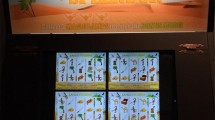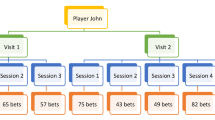Abstract
Learning theory predicts that, given the repeated choice to bet between two concurrently available slot machines, gamblers will learn to bet more money on the machine with higher expected return (payback percentage) or higher win probability per spin (volatility). The purpose of this study was to investigate whether this occurs when the two machines vary orthogonally on payback percentage and volatility. The sample comprised 52 first year psychology students (mean age = 20.3 years, 20 females, 32 males) who had played a gaming machine at least once in the previous 12 months. Participants were administered a battery of questionnaires designed to assess level of knowledge on the characteristics and operation of poker machines, frequency of poker machine play in the past 12 months, personality traits of impulsivity and capacity for cognitive reflection, and gambling beliefs. For the experimental task, participants were instructed to play on two PC-simulated electronic gaming machines (EGMs or slot machines) that differed on payback percentage and volatility, with the option of freely switching between EGMs after a practice phase. Results indicated that participants were able to easily discriminate between machines and manifested a preference to play machines offering higher payback or volatility. These findings diverged from previous findings of no preference for play on higher payback/volatility machines, potentially due to of the current study’s absence of the option to make multi-line and multi-credit bets. It was concluded that return rate parameters like payback percentage and volatility strongly influenced slot machine preference in the absence of betting options like multi-line bets, though more research is needed to determine the effects of such betting options on player distribution of money between multiple EGMs.
Similar content being viewed by others
References
Abbott, M. W. (2001). Problem and non-problem gamblers in New Zealand: A report on phase two of the 1999 national prevalence survey. Report number six of the New Zealand gaming survey. Wellington: Department of Internal Affairs.
Blaszczynski, A., & Nower, L. (2002). A pathways model of problem and pathological gambling. Addiction, 97, 487–499.
Blaszczynski, A., Sharpe, L., Walker, M., Shannon, K., & Coughlan, M. (2005). Structural characteristics of electronic gaming machines and satisfaction of play among recreational and problem gamblers. International Gambling Studies, 5, 187–198.
Brandt, A. E., & Pietras, C. J. (2008). Gambling on a simulated slot machine under conditions of repeated play. The Psychological Record, 58, 405–426.
Breen, R. B., & Zimmerman, M. (2002). Rapid onset of pathological gambling in machine gamblers. Journal of Gambling Studies, 18(1), 31–43.
Chóliz, M. (2010). Experimental analysis of the game in pathological gamblers: Effect of the immediacy of the reward in slot machines. Journal of Gambling Studies, 26, 249–256.
Cyders, M. A., & Smith, G. T. (2008). Clarifying the role of personality dispositions in risk for increased gambling behavior. Personality and Individual Differences, 45, 503–508.
Cyders, M. A., Smith, G. T., Spillane, N. S., Fischer, S., Annus, A. M., & Peterson, C. (2007). Integration of impulsivity and positive mood to predict risky behavior: Development and validation of a measure of positive urgency. Psychological Assessment, 19, 107–118.
Delfabbro, P., Falzon, K., & Ingram, T. (2005). The effects of parameter variations in electronic gambling simulations: Results of a laboratory-based pilot intervention. Gambling Research, 17(1), 7–25.
Delfabbro, P., Lahn, J., & Grabosky, P. (2006). It’s not what you know, but how you use it: Statistical knowledge and adolescent problem gambling. Journal of Gambling Studies, 22, 179–193.
Dickerson, M. G. (1979). FI schedules and persistence at gambling in the UK betting office. Journal of Applied Behaviour Analysis, 12, 315–323.
Dickerson, M., & Baron, E. (2000). Contemporary issues and future directions for research into pathological gambling. Addiction, 95(8), 1145–1159.
Dixon, M. R., Harrigan, K. A., Sandhu, R., Collins, K., & Fugelsang, J. A. (2010). Losses disguised as wins in modern multi-line video slot machines. Addiction, 105, 1819–1824.
Dixon, M. R., MacLin, O. H., & Daugherty, D. (2006). An evaluation of response allocations to concurrently available slot machine simulations. Behavior Research Methods, 38, 232–236.
Dowling, N., Smith, D., & Thomas, T. (2005). Electronic gaming machines: Are they the ‘crack-cocaine’ of gambling? Addiction, 100, 33–45.
Fischer, S., & Smith, G. T. (2008). Binge eating, problem drinking, pathological gambling: Linking behaviour to shared traits and social learning. Personality and Individual Differences, 44, 789–800.
Gilliland, J. A., & Ross, N. A. (2005). Opportunities for video lottery terminal gambling in Montréal: An environmental analysis. Canadian Journal of Public Health, 96, 55–59.
Gillis, A., McDonald, J. D., & Weatherly, J. N. (2008). American Indians and non-Indians playing a slot-machine simulation: Effects of sensation seeking and payback percentage. American Indian and Alaska Native Mental Health Research, 15, 18–32.
Götestam, K. G., & Johansson, A. (2003). Characteristics of gambling and problematic gambling in the Norwegian context: A DSM-IV-based telephone interview study. Addictive Behaviors, 28, 189–197.
Griffiths, M. (1999). Gambling technologies: Prospects for problem gambling. Journal of Gambling Studies, 15, 265–283.
Habib, R., & Dixon, M. R. (2010). Neurobehavioral evidence for the “near-miss” effect in pathological gamblers. Journal of the Experimental Analysis of Behavior, 93, 313–328.
Harrigan, K. A. (2007). Slot machine structural characteristics: Distorted player views of payback percentages. Journal of Gambling Issues, 20, 215–234.
Harrigan, K. A., & Dixon, M. (2009). PAR Sheets, probabilities, and slot machine play: Implications for problem and non-problem gambling. Journal of Gambling Studies, 23, 159–174.
Harrigan, K. A., & Dixon, M. (2010). Government sanctioned “tight” and “loose” slot machines: How having multiple versions of the same slot machine game may impact problem gambling. Journal of Gambling Studies, 26(1), 159–174.
Haw, J. (2008a). Random-ratio schedules of reinforcement: The role of early wins and unreinforced trials. Journal of Gambling Issues, 21, 56–67.
Haw, J. (2008b). The relationship between reinforcement and gaming machine choice. Journal of Gambling Studies, 24, 55–61.
Herrnstein, R. J. (1970). On the law of effect. Journal of the Experimental Analysis of Behavior, 13, 243–266.
Horne, P. J., & Lowe, C. F. (1993). Determinants of human performance on concurrent schedules. Journal of Experimental Analysis of Behavior, 59, 29–60.
Jackson, A. C., Thomas, S. A., Thomason, N., Holt, T. A., & McCormack, J. (2000). Analysis of clients presenting to break even problem gambling services, July 1 1998 to June 20 1999. Client and Service Analysis Report no 5. Melbourne, VIC: Victorian Department of Human Services.
Johansson, A., Grant, J. E., Kim, S. W., Odlaug, B. L., & Götestam, K. G. (2009). Risk factors for problematic gambling: A critical literature review. Journal of Gambling Studies, 25, 67–92.
Lambos, C., & Delfabbro, P. (2007). Numerical reasoning ability and irrational beliefs in problem gambling. International Gambling Studies, 7, 157–171.
Langer, E. J. (1975). The illusion of control. Journal of Personality and Social Psychology, 32(2), 311–328.
Le Pelley, M. E. (2004). The role of associative history in models of associative learning: A selective review and hybrid model. The Quarterly Journal of Experimental Psychology, 57B(3), 193–243.
Lesieur, H. R., & Blume, S. (1987). The South Oaks Gambling Screen (SOGS): A new instrument for the identification of pathological gamblers. American Journal of Psychiatry, 144, 1184–1188.
Linnet, J., Thomsen, K. R., Møller, A., & Callesen, M. B. (2010). Event frequency, excitement and desire to gamble, among pathological gamblers. International Gambling Studies, 10(2), 177–188.
Livingstone, C., Woolley, R., Zazryn, T., Bakacs, L., & Shami, R. (2008). The relevance and role of gaming machine games and game features on the play of problem gamblers. Adelaide, SA: Independent Gambling Authority of South Australia.
Loba, P., Stewart, S. H., Klein, R. M., & Blackburn, J. M. (2002). Manipulations of the features of standard video lottery terminal (VLT) games: Effects in pathological and non-pathological gamblers. Journal of Gambling Studies, 17(4), 297–320.
Lund, I. (2006). Gambling and problem gambling in Norway: What part does the gambling machine play? Addiction Research and Theory, 14, 475–491.
MacLin, O. H., Dixon, M. R., & Hayes, L. J. (1999). A computerized slot machine simulation to investigate the variables involved in gambling behaviour. Behavior Research Methods, Instruments, & Computers, 31, 731–734.
McMillen, J., Marshall, D., Ahmed, E., & Wenzel, M. (2004). Victorian longitudinal community attitudes survey. Melbourne: Victorian Gambling Research Panel.
Monaghan, S. (2008). Responsible gambling strategies for internet gambling: The theoretical and empirical base of using pop-up messages to encourage self-awareness. Computers in Human Behavior, 25, 202–207.
Morgan, M. J. (1974). Effects of random reinforcement sequences. Journal of the Experimental Analysis of Behavior, 22, 301–310.
Peters, H., Hunt, M., & Harper, D. (2010). An animal model of slot machine gambling: The effect of structural characteristics on response latency and persistence. Journal of Gambling Studies, 26, 521–531.
Productivity Commission. (2009). Australia’s gambling industries. Canberra: Commonwealth of Australia.
Skinner, B. F. (1938). The behavior of organisms. New York: Appleton-Century-Crofts.
Steel, Z., & Blaszczynski, A. (1996). The factorial structure of pathological gambling. Journal of Gambling Studies, 12, 3–20.
Steenbergh, T. A., Meyers, A. W., May, R. K., & Whelan, J. P. (2002). Development and validation of the gambler’s belief questionnaire. Psychology of Addictive Behaviors, 16, 143–149.
Turner, N., & Horbay, R. (2004). How do slot machines and other electronic gaming machines actually work? Journal of Gambling Issues, 11, 10–50.
Urbanoski, K. A., & Rush, B. R. (2006). Characteristics of people seeking treatment for problem gambling in Ontario: Trends from 1998 to 2002. Issues: Journal of Gambling. 16.
Volberg, R. A., & Abbott, M. W. (1994). Lifetime prevalence estimates of pathological gambling in New Zealand. International Journal of Epidemiology, 23, 976–983.
Walker, M. B. (1992). The psychology of gambling. Oxford: Pergamon Press.
Walker, M. B. (2003). The seductiveness of poker machines. In Proceedings of the 13th annual conference of the National Association for Gambling Studies (pp. 12–26), Canberra.
Weatherly, J. N., & Brandt, A. E. (2004). Participants’ sensitivity to percentage payback and credit value when playing a slot-machine simulation. Behavior and Social Issues, 13, 33–50.
Weatherly, J. N., & Dixon, M. (2007). Toward an integrative behavioral model of gambling. Analysis of Gambling Behavior, 1, 4–18.
Weatherly, J. N., & Flannery, K. A. (2008). Facing the challenge: The behavioral analysis of gambling. The Behavior Analyst Today, 9, 130–142.
Weatherly, J. N., Thompson, B. J., Hodny, M., & Meier, E. (2009). Choice behavior of non-pathological women playing concurrently available slot machines: Effect of changes in payback percentages. Journal of Applied Behavioral Analysis, 42, 895–900.
Whiteside, S. P., & Lynam, D. R. (2001). The five factor model and impulsivity: Using a structural model of personality to understand impulsivity. Personality and Individual Differences, 30, 669–689.
Williamson, A., & Walker, M. (2000). Strategies for solving the insoluble: Playing to win Queen of the Nile (pp. 218–226). Lessons of the Past, Mildura: National Association for Gambling Studies.
Author information
Authors and Affiliations
Corresponding author
Rights and permissions
About this article
Cite this article
Coates, E., Blaszczynski, A. An Analysis of Switching and Non-switching Slot Machine Player Behaviour. J Gambl Stud 29, 631–645 (2013). https://doi.org/10.1007/s10899-012-9329-6
Published:
Issue Date:
DOI: https://doi.org/10.1007/s10899-012-9329-6




